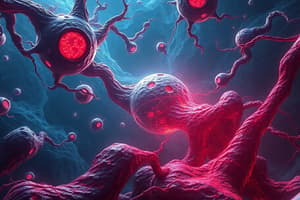Podcast
Questions and Answers
What role does p53 play in the intrinsic pathway of apoptosis?
What role does p53 play in the intrinsic pathway of apoptosis?
How do Bax and Bak contribute to the intrinsic pathway of apoptosis?
How do Bax and Bak contribute to the intrinsic pathway of apoptosis?
What is the primary function of the apoptosome in the intrinsic apoptotic pathway?
What is the primary function of the apoptosome in the intrinsic apoptotic pathway?
What is the consequence of mitochondrial outer membrane permeabilization (MOMP) in the intrinsic apoptotic pathway?
What is the consequence of mitochondrial outer membrane permeabilization (MOMP) in the intrinsic apoptotic pathway?
Signup and view all the answers
What distinguishes apoptosis from necrosis regarding the impact on DNA?
What distinguishes apoptosis from necrosis regarding the impact on DNA?
Signup and view all the answers
What is the role of Bcl-2 in the intrinsic pathway of apoptosis?
What is the role of Bcl-2 in the intrinsic pathway of apoptosis?
Signup and view all the answers
Which statement best describes the caspase cascade in apoptosis?
Which statement best describes the caspase cascade in apoptosis?
Signup and view all the answers
In the context of the intrinsic apoptotic pathway, how does oxidative stress influence the process?
In the context of the intrinsic apoptotic pathway, how does oxidative stress influence the process?
Signup and view all the answers
What is the role of FasL in the extrinsic pathway of apoptosis?
What is the role of FasL in the extrinsic pathway of apoptosis?
Signup and view all the answers
Which caspase is primarily responsible for initiating the execution phase of apoptosis?
Which caspase is primarily responsible for initiating the execution phase of apoptosis?
Signup and view all the answers
What triggers the release of cytochrome c from the mitochondria?
What triggers the release of cytochrome c from the mitochondria?
Signup and view all the answers
Which of the following statements accurately describes the formation of the Death-Inducing Signaling Complex (DISC)?
Which of the following statements accurately describes the formation of the Death-Inducing Signaling Complex (DISC)?
Signup and view all the answers
What is the function of Bid within the extrinsic pathway of apoptosis?
What is the function of Bid within the extrinsic pathway of apoptosis?
Signup and view all the answers
What role does Smac/DIABLO play in the apoptosis process?
What role does Smac/DIABLO play in the apoptosis process?
Signup and view all the answers
Which of the following best describes the function of caspase-activated DNase (CAD) in apoptosis?
Which of the following best describes the function of caspase-activated DNase (CAD) in apoptosis?
Signup and view all the answers
How do executioner caspases contribute to the process of apoptosis?
How do executioner caspases contribute to the process of apoptosis?
Signup and view all the answers
Which stage of apoptosis involves the formation of small membrane-bound vesicles?
Which stage of apoptosis involves the formation of small membrane-bound vesicles?
Signup and view all the answers
What triggers the activation of caspase-8 in the extrinsic apoptotic pathway?
What triggers the activation of caspase-8 in the extrinsic apoptotic pathway?
Signup and view all the answers
Which of the following is NOT a characteristic of the caspase cascade in apoptosis?
Which of the following is NOT a characteristic of the caspase cascade in apoptosis?
Signup and view all the answers
How does apoptosis differ from necrosis in terms of intracellular content release?
How does apoptosis differ from necrosis in terms of intracellular content release?
Signup and view all the answers
Which caspase is primarily responsible for initiating the apoptosis process?
Which caspase is primarily responsible for initiating the apoptosis process?
Signup and view all the answers
What critical role do mitochondria play in the intrinsic pathway of apoptosis?
What critical role do mitochondria play in the intrinsic pathway of apoptosis?
Signup and view all the answers
What is a primary characteristic of the DNA fragmentation that occurs during apoptosis?
What is a primary characteristic of the DNA fragmentation that occurs during apoptosis?
Signup and view all the answers
Which protein is considered part of the tumor necrosis factor receptor family involved in the extrinsic pathway?
Which protein is considered part of the tumor necrosis factor receptor family involved in the extrinsic pathway?
Signup and view all the answers
What is the end effect of the caspase cascade during apoptosis?
What is the end effect of the caspase cascade during apoptosis?
Signup and view all the answers
Which of the following phases occurs last in the apoptosis process?
Which of the following phases occurs last in the apoptosis process?
Signup and view all the answers
What main event is associated with the execution phase of apoptosis?
What main event is associated with the execution phase of apoptosis?
Signup and view all the answers
What is the primary role of autophagy during nutrient scarcity?
What is the primary role of autophagy during nutrient scarcity?
Signup and view all the answers
How does autophagy contribute to immune function?
How does autophagy contribute to immune function?
Signup and view all the answers
In embryonic development, what role does autophagy play?
In embryonic development, what role does autophagy play?
Signup and view all the answers
What is a primary consequence of necrosis compared to apoptosis?
What is a primary consequence of necrosis compared to apoptosis?
Signup and view all the answers
Which process is specifically responsible for the separation of fingers and toes during embryonic development?
Which process is specifically responsible for the separation of fingers and toes during embryonic development?
Signup and view all the answers
What is the significance of mitophagy in cellular quality control?
What is the significance of mitophagy in cellular quality control?
Signup and view all the answers
In which part of the immune system does apoptosis play a critical role in preventing autoimmunity?
In which part of the immune system does apoptosis play a critical role in preventing autoimmunity?
Signup and view all the answers
How is autophagy correlated with aging and longevity?
How is autophagy correlated with aging and longevity?
Signup and view all the answers
How does apoptosis contribute to tissue homeostasis in adult organisms?
How does apoptosis contribute to tissue homeostasis in adult organisms?
Signup and view all the answers
What role does apoptosis have in neuronal development?
What role does apoptosis have in neuronal development?
Signup and view all the answers
Which of the following statements best describes autophagy compared to apoptosis?
Which of the following statements best describes autophagy compared to apoptosis?
Signup and view all the answers
Which statement about the function of apoptosis in the immune system is correct?
Which statement about the function of apoptosis in the immune system is correct?
Signup and view all the answers
What is the main outcome of apoptosis during the embryonic stage of development?
What is the main outcome of apoptosis during the embryonic stage of development?
Signup and view all the answers
In what way can necrosis damage surrounding tissues?
In what way can necrosis damage surrounding tissues?
Signup and view all the answers
Study Notes
Apoptosis Overview
- Apoptosis is a programmed cell death essential for development, tissue maintenance, and immune regulation.
- There are two pathways of apoptosis: intrinsic and extrinsic, each having unique mediators and signaling steps.
Intrinsic Pathway (Mitochondrial-Mediated Apoptosis)
-
Triggered by internal signals: DNA damage, oxidative stress, and other cellular stresses.
-
Key Mediators:
- p53 activates pro-apoptotic proteins (e.g., Bax and Bak) upon sensing cellular stress.
- Bcl-2 is an anti-apoptotic protein that inhibits Bax and Bak activity, preventing apoptosis.
-
Key Steps:
- Cellular Stress: Internal signals activate p53, which promotes apoptosis by upregulating Bax and Bak.
- Mitochondrial Outer Membrane Permeabilization (MOMP): Bax and Bak oligomerize, forming pores in the mitochondrial membrane, releasing pro-apoptotic factors like cytochrome c.
- Apoptosome Formation: Cytochrome c binds Apaf-1, leading to the activation of procaspase-9.
- Caspase Cascade Activation: Activated caspase-9 cleaves procaspase-3, which initiates the execution process of apoptosis.
Extrinsic Pathway (Death Receptor-Mediated Apoptosis)
-
Triggered by external signals through death receptors (e.g., Fas and TNF receptors).
-
Key Steps:
- Ligand Binding: FasL or TNF-α binds to their respective receptors, recruiting adaptor proteins like FADD.
- Formation of DISC: Recruitment of procaspase-8 occurs, forming the Death-Inducing Signaling Complex.
- Caspase-8 Activation: Procaspase-8 is cleaved to active caspase-8, which activates downstream caspases.
- Cross-Talk with Intrinsic Pathway: Caspase-8 can activate Bid, linking both pathways.
Role of Caspase Cascade
- Caspases are cysteine proteases that execute the apoptotic program.
- Initiator Caspases: (caspase-8, caspase-9) initiate the apoptotic signal.
- Executioner Caspases: (caspase-3, caspase-7) cleave proteins leading to cell dismantling, such as nuclear lamins and cytoskeletal proteins.
Role of Mitochondria
- Central to apoptosis, especially in the intrinsic pathway.
- Cytochrome c Release: MOMP allows the release of cytochrome c into the cytoplasm, crucial for apoptosome formation and caspase activation.
- Releasing Pro-Apoptotic Factors: Mitochondria also release Smac/DIABLO to neutralize inhibitors of apoptosis proteins, promoting apoptosis.
DNA Fragmentation
- Activation of CAD: Caspase-activated DNase (CAD) cleaves DNA during apoptosis, generating a ladder pattern of fragments.
- Chromatin Condensation: Apoptotic cells undergo chromatin condensation, facilitating DNA fragmentation.
- Contrast with Necrosis: Unlike apoptotic DNA fragmentation, necrosis leads to cell swelling and uncontrollable release of cellular contents, causing inflammation.
Timing and Stages of Apoptosis
- Apoptosis occurs within a few hours and includes distinct phases:
- Initiation: Activation of initiator caspases.
- Execution: Activation of executioner caspases leading to cellular changes.
- DNA Fragmentation: Endonucleases cleave DNA, forming apoptotic bodies.
- Phagocytosis: Apoptotic bodies are engulfed, preventing inflammation.
Differences from Necrosis
- Apoptosis is a controlled, energy-dependent process preventing inflammation through encapsulation of apoptotic bodies.
- Necrosis is uncontrolled, causing cell lysis and inflammation through the release of cellular contents.
Role of Apoptosis in Development and Function
- Embryonic Development: Shapes tissues, eliminates excess cells and redundant structures (e.g., digits in limb formation).
- Immune Regulation: Removes self-reactive cells and excess immune cells post-response to maintain homeostasis.
- Tissue Homeostasis: Balances cell proliferation and death, removing damaged or abnormal cells to prevent cancer.
Role of Autophagy in Development and Function
- Nutrient Recycling: Autophagy degrades non-essential components during stress, providing energy and nutrients.
- Cell Differentiation: Supports differentiation by clearing unnecessary cellular components in developing cells.
- Host Defense: Engages in xenophagy to eliminate pathogens and assists in antigen presentation.
Aging and Longevity
- Maintains proteostasis and cellular quality control, preventing accumulation of damaged components linked to aging and age-related diseases.
- Enhanced autophagy correlates with increased lifespan in various model organisms.
Studying That Suits You
Use AI to generate personalized quizzes and flashcards to suit your learning preferences.
Related Documents
Description
This quiz explores the intricate processes of apoptosis, focusing on the intrinsic and extrinsic pathways. Key mediators such as Bcl-2 and p53 will be highlighted, along with the significance of the caspase cascade and mitochondria in this programmed cell death. Additionally, the quiz will cover the differences between apoptosis and necrosis, especially regarding DNA consequences.




